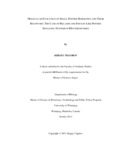| dc.contributor.author | Yegorov, Sergey | |
| dc.date.accessioned | 2013-04-18T09:13:53Z | |
| dc.date.available | 2013-04-18T09:13:53Z | |
| dc.date.issued | 2013-04-18 | |
| dc.identifier.citation | Yegorov, Sergey. Molecular Evolution of Small Peptide Hormones and Their Receptors: the Case of Relaxin and Insulin-like Peptide Signaling Systems in Deuterostomes; A thesis submitted to the Faculty of Graduate Studies in partial fulfillment of the requirements for the Master of Science degree, Department of Biology, Master of Science in Bioscience, Technology and Public Policy Program, University of Winnipeg. Winnipeg,
October 2011. | |
| dc.identifier.uri | http://hdl.handle.net/10680/432 | |
| dc.description | Parts of the research presented in this thesis have appeared in two peer reviewed publications:
1. Good, S., S. Yegorov, J. Martijn, J. Franck and J. Bogerd (2012) New Insights into Ligand-Receptor Pairing and Coevolution of Relaxin Family Peptides and their Receptors in Teleosts. International Journal of Evolutionary Biology. http://dx.doi.org/10.1155/2012/310278 .
2. Yegorov, S and Good, S.V. (2012) Using Ancestral Genome Reconstructions to study the Evolution of Ligand- Receptor Systems: the Case of Relaxin Hormones and Their Receptors. Plos One. http://dx.doi.org/10.1371/journal.pone.0032923 | en_US |
| dc.description.abstract | Relaxin family peptides are a diverse family of signalling molecules that play important roles in the regulation of reproductive and neuroendocrine processes in vertebrates. The signalling of relaxin peptides is mediated by G protein-coupled receptors of two distinct classes, small peptide receptors and leucine-rich repeat-containing receptors. The origins and evolutionary history of both relaxin family peptides and their receptors have been a matter of debate for several reasons, among which the small size of peptide molecules (~ 60 aa, often providing insufficient information for phylogenetic reconstructions) and low coverage of vertebrate taxa by functional studies have been most prominent. In this study, I combined traditional bioinformatic approaches with ancestral genome reconstructions to reassess some of the debated aspects of the evolution of relaxin peptides and their receptors. To cover a broad range of taxa, I performed thorough data mining of the focal genes in 29 publicly available genome databases of both vertebrate and invertebrate deuterostomes. Ancestral genome reconstruction-based analyses provided clear evidence for the strong influence of whole genome duplications (WGDs) on the diversification of the relaxin signaling system from a tripartite system, consisting of one hormone and two receptor-encoding genes in the vertebrate ancestor, to the present day system. The results presented here indicate that relaxin family peptide systems are more diverse than previously thought, in particular with respect to the number of genes present in different vertebrate lineages. Based on the duplication model presented here, I propose that the ancestral tripartite signaling system had a dual function which was partitioned after the first round of WGD such that two sets of ligand-receptor pairs subfunctionalized into predominantly neuroendocrine- or reproductive-focused functions. My further analyses indicated that the suite of four ligand-receptor pairs common to the majority of modern mammals and teleosts, and already present in their gnathostome ancestor, have mostly evolved under similar selection pressures, suggesting a similar function of the genes across vertebrates. However, there are some distinct patterns of selection and evidence of differential codon-specific selection in mammals versus teleosts. Lastly, the reconstruction of the ancestral states of relaxin family peptides demonstrates how the ancestral structure shared by all four peptides has changed over time and in different lineages to acquire the specific structural characteristics of the peptides that we are familiar with today. Overall, by creating an evolutionary framework for future analyses, this study should facilitate further investigation into the properties of relaxin family peptides and their receptors. | en_US |
| dc.description.sponsorship | 1-the Province of Manitoba
2-University of Winnipeg
3-Natural Sciences and Engineering Research Council of Canada | en_US |
| dc.language.iso | en | en_US |
| dc.publisher | University of Winnipeg | |
| dc.rights | info:eu-repo/semantics/openAccess | |
| dc.title | Molecular Evolution of Small Peptide Hormones and Their Receptors: the Case of Relaxin and Insulin-like Peptide Signaling Systems in Deuterostomes | en_US |
| dc.type | Thesis | en_US |
| dc.type | Thesis or Dissertation | en_US |
| dc.description.degree | Master of Science in Bioscience, Technology and Public Policy | |
| dc.publisher.grantor | University of Winnipeg | |
| thesis.degree.discipline | Bioscience, Technology and Public Policy | |
| thesis.degree.level | masters | |
| thesis.degree.name | Master of Science in Bioscience, Technology and Public Policy | |
| thesis.degree.grantor | University of Winnipeg | |

